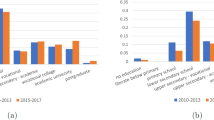Abstract
With the rapid development of China’s economy, vocational education is relatively backward, so it is of academic value and application value to study it. This paper takes Chongqing as the research object. Based on the data of Chongqing Statistical Yearbook for 2000–2016 years, SPSS software is applied to study the correlation pattern between vocational education, population structure and economic development. In terms of vocational education and population structure, the gender difference in vocational education is studied from the perspective of gender structure. Based on the Jpop-1 algorithm, the scale of future vocational education is predicted from the perspective of population age structure. In terms of vocational education and economic development, the correlation between vocational education and economic development is analyzed, and the scale change of vocational education is studied based on the elasticity coefficient.





Similar content being viewed by others
References
Fan, X. Y., & Liu, Y. (2015). Analysis on the correlation of higher vocational education investment and the economic growth in Liaoning Province. Value Engineering, 93(2), 1–7.
Chen, X., & Guo, W. X. (2016). Based on the grey correlation analysis of the empirical research of education scale and economic development—Take Xinjiang for example. Theory & Practice of Education, 12(4), 55–61.
Li, L., Zhou, H., Chen, X., et al. (2016). Layout structure of higher vocational education institutions from perspective of population and regional economic development: Taking Guangdong Province as example. Education Research Monthly, 16(1), 18–22.
Liu, Y., & Marxism, S. O. (2017). Research on the correlation between college students’ vocational values and family economic background—Based on the investigation and analysis of colleges and universities in Western China. Chongqing Higher Education Research, 4(1), 13–16.
Li, B., & Yang, X. (2015). Correlation research of higher education scale and economic growth—Based on the five northwestern provinces (area) after the enrollment expansion of colleges and universities were analyzed. Journal of National Academy of Education Administration, 8(1), 52–54.
Wang, X. F. (2015). Correlation between learning characteristics and ability of art and design students in vocational colleges. Journal of Landscape Research, 4, 91–98.
Chu, K. J. (2016). Practice research on the innovation education of secondary vocational music teaching. Heilongjiang Science, 6512, 212–216.
Funding
Funding was provided by The 2016 annual Chongqing Municipal Development and Reform Commission academic project research (Grant No. 2016YBGL126).
Author information
Authors and Affiliations
Corresponding author
Rights and permissions
About this article
Cite this article
Zhang, R., Zhao, C. Research on the Correlation Model of Vocational Talents, Population Structure and Economic Development. Wireless Pers Commun 102, 985–996 (2018). https://doi.org/10.1007/s11277-017-5127-x
Published:
Issue Date:
DOI: https://doi.org/10.1007/s11277-017-5127-x




